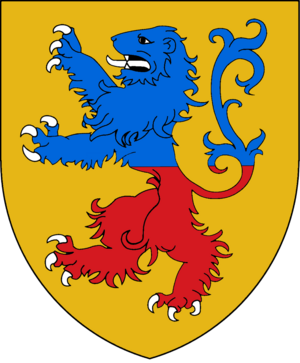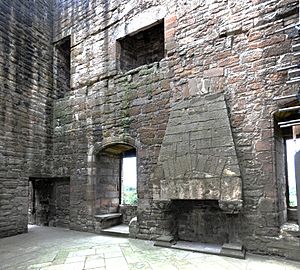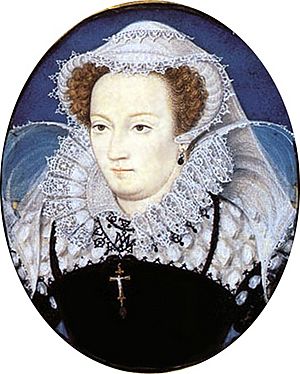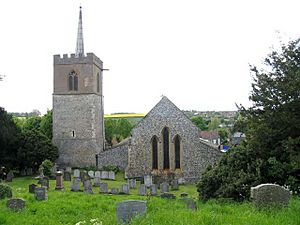Ralph Sadler facts for kids
Quick facts for kids
Sir Ralph Sadler
|
|
|---|---|

Portrait of a Man (Sir Ralph Sadler?), 1535,
Workshop of Hans Holbein the Younger |
|
| Secretary of State | |
| In office April 1540 – 23 April 1543 |
|
| Monarch | Henry VIII |
| Preceded by | Thomas Cromwell |
| Succeeded by | William Paget |
| Chancellor of the Duchy of Lancaster | |
| In office 16 May 1568 – 15 June 1587 |
|
| Monarch | Elizabeth I |
| Preceded by | Sir Ambrose Cave |
| Succeeded by | Sir Francis Walsingham |
| Personal details | |
| Born |
Ralph Sadler
1507 Hackney, Middlesex |
| Died | 30 March 1587 (aged 79–80) Standon, Hertfordshire |
| Resting place | St. Mary's Church, Standon, Hertfordshire 51°52′52″N 0°01′38″E / 51.881111°N 0.027222°E |
| Spouse | Ellen Mitchell |
| Children |
|
| Parent | Henry Sadler |
| Residences | Sutton House Standon Lordship |
Sir Ralph Sadler (1507 – 30 March 1587) was an important English statesman. He worked for four different Tudor monarchs. Ralph Sadler was a Privy Councillor, a Secretary of State, and an ambassador to Scotland.
He served King Henry VIII and King Edward VI. During the reign of Queen Mary I, he had to step back from public life. However, he returned to royal favor under Queen Elizabeth I. He became a Privy Councillor again and helped with important talks between England and Scotland. In 1568, he was made Chancellor of the Duchy of Lancaster.

Contents
Who Was Ralph Sadler?
His Family and Early Life
Ralph Sadler was born in Hackney, Middlesex, in 1507. His father, Henry Sadler, was a minor official. Henry worked for the Marquess of Dorset and Sir Edward Belknap. Ralph also had a brother named John.
Around age seven, Ralph went to live in the home of Thomas Cromwell. Cromwell later became a powerful Earl. In Cromwell's household, Ralph received an excellent education. He learned to read and write well. He also became fluent in French, Latin, and Greek. He even learned a good amount about law. Ralph was very smart and good at solving problems. He was also a skilled horseman and enjoyed falconry.
Sadler's Career in Government
Ralph Sadler started his career as a secretary for Thomas Cromwell. He then went on to serve four Tudor monarchs. During his long time in royal service, he held many important jobs. These included:
- Clerk of the Hanaper (1535–1587)
- Gentleman of the Privy Chamber (by May 1536)
- Ambassador to Scotland (1537, 1540, 1542)
- Principal Secretary (April 1540 – April 1543)
- Privy Councillor (1540–1553, 1566–1587)
- Master of the Great Wardrobe (1543–1553)
- Justice of the Peace for Hertfordshire (1544–1547, 1558/59 – 1561, 1562–1587)
- Chancellor of the Duchy of Lancaster (1568–1587)
- Lord Lieutenant for Hertfordshire (1569)
Working for Cromwell and King Henry VIII
Learning the Ropes (1526-1539)
By the time he was 19, Ralph Sadler was Thomas Cromwell's secretary. He learned a lot about how the government worked. He also learned about money and politics. He helped Cromwell with his household tasks and wrote many of his letters. By 1529, he was one of Cromwell's most trusted friends. He was even named an executor of Cromwell's will.
Sadler's skills soon caught the King's attention. He was given land from a dissolved monastery. In 1536, he became a gentleman of the Privy Chamber. He also became a Member of Parliament for Hindon.
In January 1537, Sadler went to Scotland. His job was to help improve relations between England and Scotland. He also looked into problems King Henry VIII's sister, Margaret Tudor, was having. He did well in both tasks.
The King was happy with Sadler's work. He sent him to Scotland again to try and stop a French-Scottish alliance. Sadler did not succeed in stopping the alliance. However, King Henry was still impressed with his efforts. In 1539, he was elected as an MP for Middlesex.
Becoming Secretary of State (1540-1557)
In April 1540, Sadler became a principal secretary to King Henry VIII. He shared this job with Thomas Wriothesley. In the same year, he was knighted. He also became a privy councillor. For over 30 years, he represented Hertfordshire in Parliament.
Sadler remained important even after his friend Thomas Cromwell lost power. He was briefly arrested in 1541. However, he quickly proved his loyalty and was released. He helped investigate important matters for the King. He also worked to protect the King's trust.
Diplomatic Missions to Scotland
Sadler went to Scotland many times for diplomatic missions. In 1540, he tried to weaken the power of Cardinal Beaton. Beaton was an ally of France. Sadler had letters that showed Beaton's plans. However, James V of Scotland did not believe the letters were a problem.
After the Battle of Solway Moss, Sadler returned to Scotland in March 1543. His goal was to arrange a marriage. This marriage would be between the young Mary, Queen of Scots, and Prince Edward. He successfully negotiated the Treaty of Greenwich. However, the marriage never happened.
On March 22, 1543, Sadler visited Linlithgow Palace. He saw the infant Queen Mary for the first time. He wrote that she was "as goodly a child I have seen, and like to live." Mary's mother, Mary of Guise, asked Sadler to help free Cardinal Beaton. She believed Beaton's political skills would be useful.
Sadler also watched a disagreement between the Scottish Regent and Cardinal Beaton in July 1543. After an agreement was reached, Mary was moved to Stirling Castle.
By November, Sadler felt unsafe in Edinburgh. The mood there was turning against England. He moved to Tantallon Castle, which belonged to the Earl of Angus.
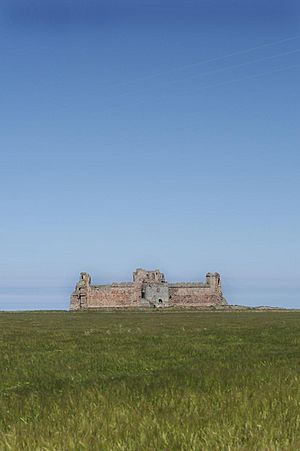
He then traveled to Berwick upon Tweed in December 1543. All his efforts to improve Anglo-Scottish relations failed. War followed after Scotland rejected the Treaty of Greenwich.
Sadler was replaced as Secretary of State in April 1543. This was because he was often away on diplomatic trips. However, he was made Master of the Great Wardrobe. He also managed the money for the war against Scotland. He joined the Earl of Hertford on his military trips to Edinburgh.
Sadler was with Lord Hertford at the Battle of Pinkie in 1547. He was the High Treasurer of the Army. For his service in the fighting, Sadler was made a knight banneret.
When King Henry VIII was preparing his will, he named Sadler to the Council of Regency. This council would rule England during Edward VI's childhood. Henry VIII also left Sadler £200 in his will.
In 1553, Sadler signed King Edward VI's will. This will aimed to make the Protestant Lady Jane Grey the next queen. Sadler was seen as someone who would support her.
Serving Mary I and Elizabeth I
During Mary I's Reign (1558)
When the Catholic Queen Mary I came to the throne, Sadler lost most of his government jobs. He was removed from the Privy Council. He was briefly held under house arrest. However, he was pardoned and lived quietly at his home in Standon, Hertfordshire. He did not serve in Parliament during Mary's reign.
Under Elizabeth I (1558-1587)
When Queen Elizabeth I became queen, Sadler was back in royal favor. On August 8, 1559, he was sent to Scotland. His mission was to create an alliance with the Scottish Protestants. He also helped the cause of the Lords of the Congregation. After England became involved in the fighting at the Battle of Leith, Sadler helped create the Treaty of Edinburgh.
In 1568, he became Chancellor of the Duchy of Lancaster. When Mary, Queen of Scots, fled to England, Sadler was asked to meet with Scottish officials about her. He was also sent to arrest the Duke of Norfolk in Scotland in 1572.
Sadler was later given the difficult job of being jailer for Mary, Queen of Scots. From 1584 to 1585, Mary was held at Wingfield Manor and Tutbury Castle under his care. Queen Elizabeth was worried about Mary's plans against her. Sadler was told to limit Mary's freedom. He had to post guards and search the castle grounds regularly. After the Babington Plot, Sadler was on the council that sentenced Mary to death.
Sadler's Marriage and Family
Around 1534, Ralph Sadler married Ellen Mitchell. She was from Much Hadham, Hertfordshire. At the time, people believed she was the widow of Matthew Barre. Ralph and Ellen had several children together:
- Sir Thomas Sadler (c. 1536 – 1607). He was named after Thomas Cromwell.
- Edward Sadler (died 1584).
- Henry Sadler (c. 1538 – 1618).
- Anne Sadler (died 1576).
- Mary Sadler.
- Jane Sadler (died c. 1587).
- Dorothy Sadler (died c. 1578).
Sadler may have also had a son named Richard.
A Legal Challenge to His Marriage
More than eleven years after Ralph and Ellen married, Matthew Barre returned. He had been in Ireland and was thought to be dead. He claimed to still be Ellen's lawful husband. This was a serious problem for Ralph Sadler. He was a wealthy and important person at court. His reputation was at risk.
Ellen Mitchell and Matthew Barre had married in 1526. They had two daughters before Barre left for Ireland. Ellen tried to find him but could not. She was later told he had died. Believing this, she married Ralph Sadler.
An investigation found that Ellen's first marriage was still valid. To fix this, Sadler had to get a special law passed by Parliament. In 1546, this law made his marriage to Ellen a true and proper union. It also made sure their children were legally recognized. Sadler managed to keep this law from being widely published. This event caused some damage to Sadler's reputation. However, it was not permanent. His marriage to Ellen was saved, and they lived together for many more years.
His Later Years and Death
Ralph Sadler's wife, Ellen, was still alive in 1569. Sir Ralph Sadler died on March 30, 1587. He was known as "the richest commoner in England." He left most of his large landholdings to his oldest son, Thomas Sadler. Ralph Sadler's tomb is in St. Mary's Church, Standon, Hertfordshire.
Fictional Stories About Sir Ralph Sadler
Sir Ralph Sadler appears as a main character in some historical novels. These include:
- Wolf Hall by Hilary Mantel. This book tells a fictional story of Sadler's youth. He is shown working in Thomas Cromwell's household.
- Bring Up the Bodies and The Mirror & the Light. These are sequels to Wolf Hall.
- The Other Queen by Philippa Gregory. In this book, Sadler is a minor character. It describes his time as Mary, Queen of Scots' jailer.
- The Queenmaker Series by Caroline Angus. This series focuses on Thomas Cromwell's life. Ralph Sadler's rise at court and his role as an ambassador are also featured.
See also


